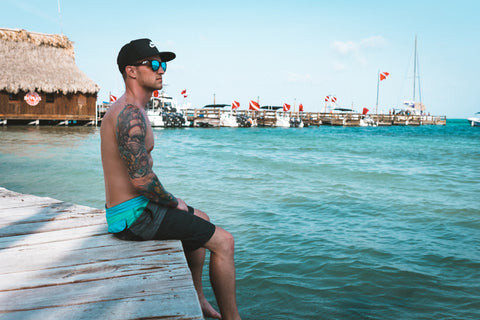Thinking about swimming after getting inked? It’s a common question! At tattooat.com, we understand the excitement of showing off your new tattoo, but ensuring proper healing is key. Knowing when you can safely swim after getting a tattoo is crucial for preserving its vibrancy and preventing infection, so read on to find out how to keep your tattoos looking fresh. We’ll cover everything from aftercare tips to potential risks, empowering you to make informed decisions about your body art journey and how to maintain it over time.
1. Why Swimming with a New Tattoo Is Risky
Swimming with a new tattoo is generally discouraged because it introduces several risks to the healing process. Your fresh tattoo needs time to form a protective barrier against infection, and swimming can compromise this delicate stage. Understanding these risks helps you make informed choices about your aftercare routine.
1.1. Submerging New Tattoos Is Problematic
Submerging a new tattoo in water, whether it’s a pool, ocean, or bath, can disrupt the healing process. Prolonged water exposure softens the skin and the newly forming protective layer, making it vulnerable to damage. According to dermatologists at the American Academy of Dermatology, keeping a new tattoo dry is crucial for proper healing.
1.2. Infection Risks in Water
Water, even in treated pools, harbors bacteria that can cause infections in open wounds, such as a new tattoo. Natural bodies of water like lakes and oceans contain even higher levels of microorganisms, increasing the risk of complications. Infections can lead to scarring, discoloration, and prolonged healing times.
1.3. Chemical Irritation from Pool Water
Chemicals like chlorine, commonly found in swimming pools, can irritate and damage a new tattoo. Chlorine can dry out the skin, cause inflammation, and potentially fade the tattoo’s colors. The National Swimming Pool Foundation recommends maintaining specific chemical levels in pools, but even properly treated water can pose risks to a healing tattoo.
 Fresh tattoo exposed to pool chemicals
Fresh tattoo exposed to pool chemicals
2. How Long to Wait Before Swimming After a Tattoo
The recommended waiting period before swimming after getting a new tattoo varies, but erring on the side of caution is always best. Factors like the size and location of the tattoo, as well as individual healing rates, can influence this timeline. Following expert guidelines ensures optimal healing and reduces the risk of complications.
2.1. Minimum Two Weeks Waiting Period
Most tattoo artists and dermatologists advise waiting at least two weeks before submerging a new tattoo in water. This allows the initial healing phase to occur, where the outer layers of skin begin to close and form a protective barrier. However, this is just a minimum guideline, and more extended waiting periods are often recommended.
2.2. Ideal Waiting Period: Four to Six Weeks
The ideal waiting period before swimming after getting a tattoo is typically four to six weeks. This timeframe allows for more complete healing, reducing the risk of infection and ensuring the tattoo’s long-term vibrancy. According to a study by the Tattoo Society of North America, tattoos generally take around six weeks to fully heal beneath the surface of the skin.
2.3. Factors Influencing Healing Time
Several factors can influence how quickly a tattoo heals, including:
- Tattoo Size and Location: Larger tattoos and those in areas with more movement (e.g., joints) may take longer to heal.
- Individual Healing Rate: Each person’s body heals at a different pace, influenced by factors like age, health, and lifestyle.
- Aftercare Practices: Proper cleaning and moisturizing can significantly speed up the healing process.
| Factor | Impact on Healing Time |
|---|---|
| Tattoo Size | Larger = Slower |
| Tattoo Location | Joints = Slower |
| Individual Health | Better Health = Faster |
| Aftercare Compliance | Higher Compliance = Faster |
3. Protecting Your Tattoo If You Must Swim
In some situations, swimming may be unavoidable despite having a new tattoo. Taking precautions to protect the tattoo is essential to minimize the risks of infection and damage. Using waterproof barriers and following specific aftercare steps can help safeguard your body art.
3.1. Waterproof Bandages: SaniDerm and Similar Products
Waterproof bandages like SaniDerm or Tegaderm can provide a protective barrier between the tattoo and water. These breathable films adhere to the skin, preventing water and bacteria from penetrating the tattooed area. Ensure the bandage is applied correctly, with no gaps or wrinkles that could allow water to seep in.
3.2. Application Tips for Waterproof Bandages
When applying waterproof bandages, follow these tips to ensure a secure seal:
- Clean and Dry Skin: Ensure the skin around the tattoo is clean and completely dry before application.
- Overlap Edges: Overlap the bandage edges slightly onto the surrounding skin to create a watertight seal.
- Smooth Out Wrinkles: Smooth out any wrinkles or air bubbles to ensure the bandage adheres properly.
- Regular Checks: Regularly check the bandage while swimming to ensure it remains secure and water isn’t seeping in.
3.3. Post-Swim Aftercare
Even with protection, proper aftercare is essential after swimming with a new tattoo. Remove the bandage immediately after swimming, gently clean the tattoo with mild soap and water, and pat it dry with a clean towel. Apply a thin layer of tattoo-friendly moisturizer to keep the skin hydrated.
4. What Happens If Your New Tattoo Gets Wet?
Accidents happen, and sometimes a new tattoo may get wet despite your best efforts. Knowing how to respond in such situations can help minimize potential damage and prevent infection. Quick and appropriate action is key to maintaining the health of your tattoo.
4.1. Minor Water Exposure: Showering
If your tattoo gets slightly wet while showering, don’t panic. Gently pat the area dry with a clean towel and ensure it’s not excessively saturated. Avoid direct water pressure on the tattoo and limit the duration of exposure.
4.2. Submerging the Tattoo Accidentally
If you accidentally submerge your new tattoo while bathing or swimming, immediately remove it from the water. Clean the area thoroughly with antibacterial soap and apply a thin layer of aftercare ointment. Monitor the tattoo closely for any signs of infection, such as redness, swelling, or pus.
4.3. Recognizing Signs of Infection
Knowing the signs of a tattoo infection is crucial for prompt treatment. Common symptoms include:
- Excessive Redness: Increased redness around the tattoo.
- Swelling: Noticeable swelling and inflammation.
- Pain: Persistent or worsening pain.
- Pus or Drainage: Any discharge from the tattoo.
- Fever: In severe cases, fever may accompany the infection.
If you experience any of these symptoms, consult a healthcare professional immediately.
5. Alternative Activities During the Healing Period
The healing period after getting a tattoo doesn’t have to be boring. There are plenty of alternative activities you can enjoy while keeping your new ink protected. Exploring these options ensures you stay entertained without compromising your tattoo’s healing process.
5.1. Staying Active Without Submerging
Engage in activities that don’t involve submerging your tattoo in water, such as:
- Gym Workouts: Focus on exercises that don’t involve excessive sweating directly on the tattoo.
- Outdoor Adventures: Hiking, biking, and other outdoor activities are great as long as you protect your tattoo from the sun and dirt.
- Yoga and Stretching: Gentle yoga and stretching can help you stay flexible and relaxed.
5.2. Creative Pursuits
Use the healing period as an opportunity to explore creative hobbies, such as:
- Drawing and Painting: Get inspired by your new tattoo and create art of your own.
- Writing: Start a journal or work on a creative writing project.
- Music: Learn a new instrument or practice your singing.
5.3. Social Activities
Stay connected with friends and family through activities that don’t involve water, such as:
- Game Nights: Host a board game night or play video games with friends.
- Movie Marathons: Enjoy a cozy movie marathon at home.
- Dining Out: Explore new restaurants and cuisines.
6. Tattoo Aftercare Essentials
Proper tattoo aftercare is critical for ensuring your tattoo heals correctly and remains vibrant for years to come. Following a consistent aftercare routine helps prevent infection, reduces scarring, and preserves the integrity of the design. Understanding these essentials is key to maintaining the beauty of your body art.
6.1. Cleaning the Tattoo
Gently clean your new tattoo with mild, fragrance-free soap and warm water two to three times a day. Use your fingertips to wash the area, avoiding harsh scrubbing or abrasive materials. Rinse thoroughly and pat dry with a clean, soft towel or paper towel.
6.2. Moisturizing the Tattoo
Apply a thin layer of tattoo-specific aftercare ointment or a fragrance-free, hypoallergenic moisturizer after each cleaning. Avoid using petroleum-based products, as they can clog pores and hinder healing. Keep the tattoo moisturized but not excessively greasy.
6.3. Protecting from the Sun
Sun exposure can cause tattoo fading and damage. Protect your tattoo by wearing loose-fitting clothing or applying a broad-spectrum, high-SPF sunscreen specifically designed for tattoos. Reapply sunscreen every two hours when exposed to the sun.
7. Long-Term Tattoo Care
While the initial healing period is critical, long-term care is essential for maintaining the vibrancy and clarity of your tattoo. Consistent attention to your tattoo’s needs will help it look its best for years to come. Incorporating these practices into your routine ensures your body art remains a source of pride.
7.1. Regular Moisturizing
Continue to moisturize your tattoo daily, even after it has fully healed. This helps keep the skin hydrated and prevents the tattoo from looking dull or faded. Choose a high-quality, fragrance-free moisturizer that suits your skin type.
7.2. Sun Protection
Protect your tattoo from the sun year-round, even on cloudy days. UV rays can damage the ink and cause it to fade over time. Use sunscreen with a high SPF and wear protective clothing whenever possible.
7.3. Healthy Lifestyle
A healthy lifestyle can also contribute to the longevity of your tattoo. Stay hydrated, eat a balanced diet, and avoid smoking and excessive alcohol consumption. Healthy skin is better able to retain the ink and maintain its vibrancy.
8. Common Misconceptions About Tattoo Aftercare
Many myths and misconceptions surround tattoo aftercare. Separating fact from fiction is crucial for ensuring you’re taking the best possible care of your new tattoo. Addressing these misconceptions can prevent unnecessary complications and promote proper healing.
8.1. “Letting the Tattoo Air Out”
Contrary to popular belief, letting a tattoo “air out” is not beneficial. In fact, it can dry out the skin and slow down the healing process. Keeping the tattoo moisturized is essential for promoting cell regeneration and preventing scabbing.
8.2. “Using Petroleum-Based Products”
Petroleum-based products like Vaseline were once commonly recommended for tattoo aftercare, but they can actually hinder healing. These products can clog pores and prevent the skin from breathing, increasing the risk of infection. Opt for tattoo-specific aftercare ointments or fragrance-free, hypoallergenic moisturizers instead.
8.3. “Picking Scabs”
Picking scabs is a big no-no in tattoo aftercare. Scabs are a natural part of the healing process, and picking them can lead to scarring and ink loss. Allow scabs to fall off naturally to ensure proper healing and prevent damage to the tattoo.
9. Finding a Reputable Tattoo Artist
The quality of your tattoo experience starts with choosing a reputable and experienced tattoo artist. A skilled artist will not only create a beautiful design but also provide guidance on proper aftercare techniques. Researching and selecting the right artist is crucial for a positive and safe experience.
9.1. Researching Artists
Before choosing an artist, research their portfolio, read reviews, and check their credentials. Look for artists who specialize in the style you’re interested in and have a strong reputation for hygiene and safety. Websites like tattooat.com can help you find reputable artists in your area.
9.2. Checking Studio Hygiene
Visit the tattoo studio and observe the cleanliness and hygiene practices. Ensure the studio is licensed and follows proper sterilization procedures. A clean and organized environment is essential for preventing infections.
9.3. Consultation and Aftercare Advice
Schedule a consultation with the artist to discuss your design ideas and ask about their aftercare recommendations. A good artist will provide detailed instructions on how to care for your new tattoo and answer any questions you may have.
10. Real-Life Scenarios and Expert Advice
To provide a comprehensive understanding of swimming after a tattoo, let’s explore some real-life scenarios and expert advice from tattoo artists and dermatologists. These insights offer practical guidance and address common concerns.
10.1. Scenario 1: Vacation Plans
Scenario: You have a beach vacation planned shortly after getting a new tattoo.
Advice: “I always advise my clients to avoid swimming for at least four weeks,” says renowned tattoo artist Anya Petrova. “The ocean is full of bacteria, and even with waterproof bandages, the risk is too high. Enjoy the sun, but keep your tattoo covered and dry.”
10.2. Scenario 2: Gym Enthusiast
Scenario: You’re a gym enthusiast and swim regularly for exercise.
Advice: “If you can’t avoid swimming, use a waterproof bandage and apply a thin layer of antibacterial ointment after each session,” advises dermatologist Dr. Mark Thompson. “Monitor the tattoo closely for any signs of irritation or infection, and consult a doctor if needed.”
10.3. Scenario 3: Accidental Exposure
Scenario: You accidentally submerged your tattoo while washing dishes.
Advice: “Don’t panic,” says experienced tattoo artist Ben Carter. “Gently clean the area with mild soap and water, pat it dry, and apply a thin layer of aftercare ointment. Keep an eye on it, but minor exposure is usually not a major issue if you act quickly.”
These scenarios and expert insights aim to provide you with practical guidance and address common concerns, empowering you to make informed decisions about your tattoo aftercare.
Ready to dive deeper into the world of tattoos? Explore countless design inspirations, find talented artists, and get all your aftercare questions answered at tattooat.com. Your perfect tattoo journey starts here!
FAQ: Swimming After a Tattoo
How soon after getting a tattoo can I swim in a pool?
You should wait at least two weeks, but ideally four to six weeks, before swimming in a pool after getting a new tattoo to allow it to heal properly and avoid infection.
Can I take a bath instead of swimming?
No, taking a bath is not recommended during the initial healing period as prolonged soaking can disrupt the healing process and increase the risk of infection.
What happens if my new tattoo gets wet in the shower?
If your new tattoo gets wet in the shower, gently pat it dry with a clean towel and ensure it’s not excessively saturated. Avoid direct water pressure on the tattoo.
Are there any waterproof bandages that are safe for tattoos?
Yes, waterproof bandages like SaniDerm or Tegaderm can provide a protective barrier between the tattoo and water, but ensure they are applied correctly and checked regularly.
Can chlorine in pools affect my new tattoo?
Yes, chlorine can irritate and damage a new tattoo, causing dryness, inflammation, and potentially fading the tattoo’s colors.
What are the signs of a tattoo infection?
Signs of a tattoo infection include excessive redness, swelling, pain, pus or drainage, and in severe cases, fever.
Should I moisturize my tattoo after it gets wet?
Yes, after gently drying your tattoo, apply a thin layer of tattoo-friendly moisturizer to keep the skin hydrated and promote healing.
Is it safe to swim in the ocean after getting a tattoo?
Swimming in the ocean is generally riskier than swimming in a pool due to the higher levels of bacteria and microorganisms in natural bodies of water. It’s best to wait at least four to six weeks.
Can I use Vaseline on my new tattoo?
No, it is generally not recommended to use Vaseline on a new tattoo as it can clog pores and hinder healing. Opt for tattoo-specific aftercare ointments or fragrance-free, hypoallergenic moisturizers instead.
How can I protect my tattoo from the sun?
Protect your tattoo by wearing loose-fitting clothing or applying a broad-spectrum, high-SPF sunscreen specifically designed for tattoos. Reapply sunscreen every two hours when exposed to the sun.
Address: 1825 SW Broadway, Portland, OR 97201, United States.
Phone: +1 (503) 725-3000.
Website: tattooat.com.

